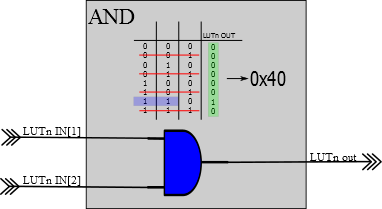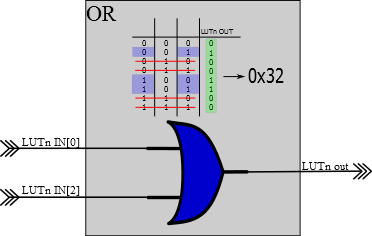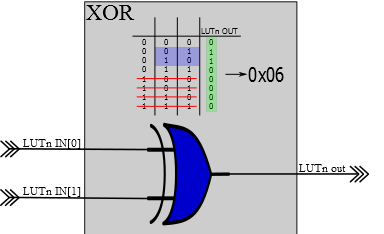Each LUT has three inputs that can be used. When not all the three inputs are needed,
the unused input can be masked (tied low). Only the TRUTH bits where the masked input is
'0' can be used when looking at the truth table to determine how
the bits may be set to get the wanted logic.
When masking one input, the truth table can be simplified to have only two inputs and when masking two inputs it can be reduced to have only one input.
The table below shows an example of the truth table when masking IN[0].
| IN[2] | IN[1] | OUT |
|---|---|---|
| 0 | 0 | TRUTH[0] |
| 0 | 1 | TRUTH[2] |
| 1 | 0 | TRUTH[4] |
| 1 | 1 | TRUTH[6] |
The table below shows an example of the truth table when masking IN[1].
| IN[2] | IN[0] | OUT |
|---|---|---|
| 0 | 0 | TRUTH[0] |
| 0 | 1 | TRUTH[1] |
| 1 | 0 | TRUTH[4] |
| 1 | 1 | TRUTH[5] |
The table below shows an example of the truth table when masking IN[2].
| IN[1] | IN[0] | OUT |
|---|---|---|
| 0 | 0 | TRUTH[0] |
| 0 | 1 | TRUTH[1] |
| 1 | 0 | TRUTH[2] |
| 1 | 1 | TRUTH[3] |
The table below shows an example of the truth table when masking IN[0] and IN[1].
| IN[2] | OUT |
|---|---|
| 0 | TRUTH[0] |
| 1 | TRUTH[4] |
The table below shows an example of the truth table when masking IN[0] and IN[2].
| IN[1] | OUT |
|---|---|
| 0 | TRUTH[0] |
| 1 | TRUTH[2] |
The table below shows an example of the truth table when masking IN[1] and IN[2].
| IN[0] | OUT |
|---|---|
| 0 | TRUTH[0] |
| 1 | TRUTH[1] |
Below are some examples of where various inputs are masked.


